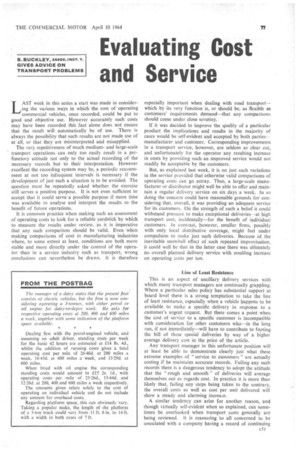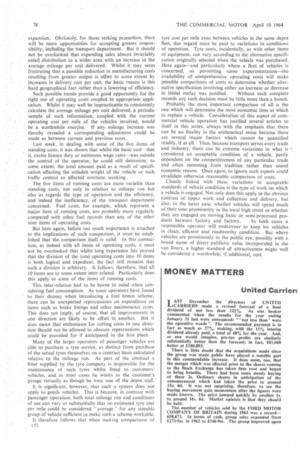Evaluating Cost and Service
Page 79

Page 80

If you've noticed an error in this article please click here to report it so we can fix it.
L_
AST week in this series a start was made in consider ing the various ways in which the cost of operating commercial vehicles, once recorded, could be put to good and objective use. However accurately such costs may have been recorded this fact alone does not ensure that the result will automatically be of use. There is always the possibility that such results are not made use of at all, or that they are misinterpreted and misapplied.
The very repetitiveness of much mediumand large-scale transport operations can only too easily result in a perfunctory attitude not only to the actual recording of the necessary records but to their interpretation. However excellent the recording system may be, a periodic reassessment at not too infrequent intervals is necessary if the development of just such a situation is to be avoided. The question must be repeatedly asked whether the exercise still serves a positive purpose. It is not even sufficient to accept that it could serve a possible purpose if more time was available to analyse and interpret the results to the benefit of future operations.
• It is common practice when making such an assessment of operating costs to look for a reliable yardstick by which to measure the results under review, as it is imperative that any such comparison should be valid. Even when making comparisons of cost in manufacturing industries where, to some extent at least, conditions are both more stable and more directly under the control of the operator tha.n in a service industry such as transport, wrong conclusions can nevertheless be drawn. It is therefore especially important when dealing with road transport— which by its very function is, or should be, as flexible as customers' requirements demand—that any comparisons should come under close scrutiny.
If it was decided to improve the quality of a particular product the implications and results in the majority of cases would be self-evident and accepted by both parties-manufacturer and customer. Corresponding improvements in a transport service, however, are seldom as clear cut, and unfortunately for the operator any resulting increase in costs by providing such an improved service would not readily be acceptable by the customers.
But, as explained last week, it is on just such variations in the service provided that otherwise valid comparisons of operating costs can go astray. Thus, a large-scale manufacturer or distributor might well he able to offer and maintain a regular delivery service on six days a week. In so doing the concern could have reasonable grounds for considering that, overall, it was providing an adequate service for its customers. On the strength of such a belief it could withstand pressure to make exceptional deliveries—at high transport cost, incidentally—for the benefit of individual customers. In contrast, however, smaller firms, possibly with only local distributive coverage, might feel under compulsion to make just such deliveries. Because of the inevitable snowball effect of such repeated improvisation, it could well be that in the latter case there was ultimately no overall planned delivery service with resulting increase on operating costs per ton.
Line of Least Resistance This is an aspect of ancillary delivery services with which many transport managers are continually grappling. Where a particular sales policy has substantial support at board level there is a strong temptation to take the line of least resistance, especially when a vehicle happens to be available to make a specific delivery in response to a customer's urgent request. But there comes a point when the cost of service to a specific customer is incompatible with consideration for other customers who—in the long run, if not immediately—will have to contribute to footing the bill of these special deliveries by way of a higher average delivery cost in the price of the article.
Any transport manager in this unfortunate position will at least be able to demonstrate clearly just what these extreme examples of "service to customers" are actually costing if he maintains accurate records. Failing any such records there is a dangerous tendency to adopt the attitude that the "rough and smooth" of deliveries will average themselves out as regards cost. In practice it is more than likely that, failing any steps being taken to the contrary, the overall costs as well as cost per unit delivered will show a steady and alarming increase.
A similar tendency can arise for another reason, and though virtually self-evident when so explained, can sometimes be overlooked when transport costs generally are being reviewed. It is reassuring to all concerned to be associated with a company having a record of continuing expansion. Obviously, for those seeking promotion, there will be More opportunities for accepting greater responsibility, including the transport department. But it should not be overlooked that expanding sales almost invariably entail distribution to a wider area with an increase in the average mileage per unit delivered. Whilst it may seem frustrating that a possible reduction in manufacturing costs resulting from greater output is offset to some extent by increases-in delivery cost per unit, the basic reason is this hard geographical fact rather than a lowering of efficiency.
Such possible trends provide a good opportunity for the right use of operating costs coupled to appropriate application. Whilst it may well be impracticable to consistently calculate the average mileage per unit delivered, a periodic .sample of such information, coupled with the current operating cost per mile of the vehicles involved, would be a worthwhile exercise. If any mileage increase was thereby revealed a. corresponding adjustment could be made as between current and previous costs.
• Last week, in dealing with some of the five items of standing costs, it was shown that whilst the basic cost that is, excise licence duty or minimum wage rates—was outside the control of the operator, he could still determine, to some extent, the total amount paid as a result of specification affecting the unladen weight of the vehicle or such traffic control as affected overtime working.
The five items of running costs are more variable than standing costs, not only in relation to mileage run but also as regards the type of operation and the efficiency, and indeed the inefficiency, of the transport department concerned. Fuel costs, for example, which represent a major item of running costs, are probably more regularly compared with other fuel records than any of the other nine items of operating costs.
But here again, before too much importance is attached to the implications of such comparison, it must be established that the comparison itself is valid. In this connection, as indeed with all items of operating costs, it must not be overlooked that whilst long experience has proved that the division of the total operating costs into 10 items is both logical and expedient, the fact still remains that such a division is arbitrary. It follows, therefore, that all 10 items are to some extent inter-related. Particularly does this apply to some of the items of running costs.
This inter-relation had to be borne in mind when considering fuel consumption. As some operators have found to their dismay when introducing a fuel bonus scheme, there can be unexpected repercussions on expenditure on items such as brake linings and other maintenance costs. This does not imply, of course, that all improvements in one direction are likely to be offset in another. But it does mean that enthusiasm for cutting costs in one direction ghould not be allowed to obscure repercussions which could be provided for if anticipated in the first place.
Many of the larger operators of passenger vehicles are able to purchase a tyre service, as distinct from purchase of the actual tyres themselves on a contract basis calculated relative to the mileage run. As part of the contract a fitter supplied by the tyre company is responsible for the maintenance of such tyres whilst fitted to customers' vehicles, and in most cases he works in the customer's garage virtually as though he were one of the depot staff.
It is significant, however, that such a system does not• apply to goods vehicles. This is because, in contrast with passenger operation, both total mileage run and conditions of use can vary so substantially that no estimated tyre cost per mile could be considered "average" for any sizeable group of vehicle sufficient to make such a scheme workable.
It therefore follows that when making comparisons of
c52 tyre cost per mile even betweenvehicles in the same depot fleet, due regard must be paid to variations in conditions of operation. Tyre costs, incidentally, as with other items of equipment, can vary according to the alternative specification originally selected when the vehicle was purchased. Here again—and particularly where a fleet of vehicles is concerned, so permitting some experimentation—the availability of comprehensive operating costs will make possible comparisons of costs to determine whether alternative specification involving either an increase or decrease in initial outlay was justified. Without such complete records any such decision must be little more than a hunch_ Probably the most important comparison of all is the one which will determine the most economic time at which to replace a vehicle. Consideration of this aspect of commercial vehicle operation has justified several articles to itself in this series, always with the emphasis that there can be no finality in the arithmetical sense because there are several major factors which cannot be quantified readily, if at all. Thus, because transport serves every trade and industry, there can be extreme variations in what is considered an acceptable condition of a vehicle, partly dependent on the competitiveness of any particular trade and often stemming from tradition rather than sound economic reason, Once again, to ignore such aspects could invalidate otherwise reasonable comparison of costs.
Closely linked with these variations in acceptable standards of vehicle condition is the type of work on which a vehicle is engaged. Not only does this apply to the obvious contrast of tipper work and collection and delivery, but also, in the latter case, whether vehicles will spend much of their time prominently in the local high street or whether they are engaged on moving basic or semi-processed pro
ducts between factory and factory. In both cases a responsible operator will endeavour to keep his vehicles in clean, efficient and roadworthy condition. But where vehicles are prominently in the public eye, possibly with a brand name of direct publicity value incorporated in the van livery, a higher standard of attractiveness might well be considered a worthwhile, if additional, cost.
























































































































